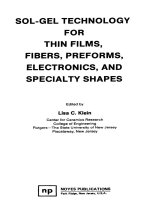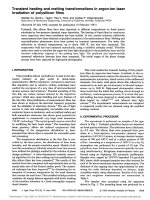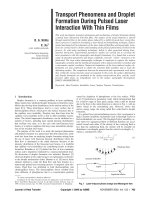Nanocoating and ultra-thin films
Bạn đang xem bản rút gọn của tài liệu. Xem và tải ngay bản đầy đủ của tài liệu tại đây (8.57 MB, 444 trang )
Nanocoatings and ultra-thin films
© Woodhead Publishing Limited, 2011
Related titles:
Nanostructured metals and alloys
(ISBN 978-1-84569-670-2)
Nanostructured metals and alloys have enhanced tensile strength, fatigue strength
and ductility and are suitable for use in applications where strength or strength-toweight ratios are important. Part I of this important book reviews processing techniques for bulk nanostructured metals and alloys. Parts II and III discuss
microstructure and mechanical properties, whilst part IV outlines applications of
this new class of material.
Electroless copper and nickel-phosphorus plating
(ISBN 978-1-84569-808-9)
Compared with electroplating, electroless plating allows uniform deposits over different surfaces. Electroless copper and nickel-phosphorus deposits provide protective and functional coatings in industries as diverse as electronics, automotive,
aerospace and chemical engineering. Written by leading experts in the field, this
important book reviews the deposition process and the key properties of electroless
copper and nickel-phosphorus deposits as well as their practical applications.
Thermal barrier coatings
(ISBN 978-1-84569-658-0)
Thermal barrier coatings are used to counteract the effects of high temperature
corrosion and degradation of materials exposed to environments with high operating temperatures. The book covers both ceramic and metallic thermal barrier coatings as well as the latest advances in physical vapour deposition and plasma spraying
techniques. Advances in nanostructured thermal barrier coatings are also discussed.
The book reviews potential failure mechanisms in thermal barrier coatings as well
as ways of testing performance and predicting service life. A final chapter reviews
emerging materials, processes and technologies in the field.
Details of these and other Woodhead Publishing materials books can be obtained
by:
•
•
•
visiting our website at www.woodheadpublishing.com
contacting Customer Services (e-mail: ; fax: +44
(0) 1223 832819; tel.: +44 (0) 1223 499140 ext. 130; address: Woodhead Publishing
Limited, 80 High Street, Sawston, Cambridge CB22 3HJ, UK)
contacting our US office (e-mail: ; tel.
(215) 928 9112; address: Woodhead Publishing, 1518 Walnut Street, Suite 1100,
Philadelphia, PA 19102-3406, USA)
If you would like to receive information on forthcoming titles, please send your
address details to: Francis Dodds (address, tel. and fax as above; e-mail: francis.
). Please confirm which subject areas you are
interested in.
© Woodhead Publishing Limited, 2011
Nanocoatings and
ultra-thin films
Technologies and applications
Edited by
Abdel Salam Hamdy Makhlouf
and Ion Tiginyanu
Oxford
Cambridge
Philadelphia
New Delhi
© Woodhead Publishing Limited, 2011
Published by Woodhead Publishing Limited,
80 High Street, Sawston, Cambridge CB22 3HJ, UK
www.woodheadpublishing.com
Woodhead Publishing, 1518 Walnut Street, Suite 1100, Philadelphia, PA 191023406, USA
Woodhead Publishing India Private Limited, G-2, Vardaan House, 7/28 Ansari
Road, Daryaganj, New Delhi – 110002, India
www.woodheadpublishingindia.com
First published 2011, Woodhead Publishing Limited
© Woodhead Publishing Limited, 2011
The authors have asserted their moral rights.
This book contains information obtained from authentic and highly regarded
sources. Reprinted material is quoted with permission, and sources are indicated.
Reasonable efforts have been made to publish reliable data and information, but
the authors and the publishers cannot assume responsibility for the validity of all
materials. Neither the authors nor the publishers, nor anyone else associated with
this publication, shall be liable for any loss, damage or liability directly or
indirectly caused or alleged to be caused by this book.
Neither this book nor any part may be reproduced or transmitted in any form
or by any means, electronic or mechanical, including photocopying, microfilming
and recording, or by any information storage or retrieval system, without
permission in writing from Woodhead Publishing Limited.
The consent of Woodhead Publishing Limited does not extend to copying for
general distribution, for promotion, for creating new works, or for resale. Specific
permission must be obtained in writing from Woodhead Publishing Limited for
such copying.
Trademark notice: Product or corporate names may be trademarks or registered
trademarks, and are used only for identification and explanation, without intent to
infringe.
British Library Cataloguing in Publication Data
A catalogue record for this book is available from the British Library.
Library of Congress Control Number: 2011934932
ISBN 978-1-84569-812-6 (print)
ISBN 978-0-85709-490-2 (online)
The publisher’s policy is to use permanent paper from mills that operate a
sustainable forestry policy, and which has been manufactured from pulp
which is processed using acid-free and elemental chlorine-free practices.
Furthermore, the publisher ensures that the text paper and cover board used
have met acceptable environmental accreditation standards.
Typeset by Toppan Best-set Premedia Limited, Hong Kong
Printed by TJI Digital, Padstow, Cornwall, UK
© Woodhead Publishing Limited, 2011
Contents
Contributor contact details
Introduction
Part I
Technologies
1
Current and advanced coating technologies for
industrial applications
A. S. H. Makhlouf, Max Planck Institute of Colloids
and Interfaces, Germany
Introduction
Electro- and electroless chemical plating
Conversion coatings
Chemical and physical vapor deposition
(CVD and PVD)
Spray coating
Other coating techniques
New lightweight materials
Trends in environmentally friendly coatings,
self-assembling and self-cleaning coatings
Trends in nanocoatings
New composite and powder coatings
Advanced polymers and fillers
Developments in coating processes
Acknowledgements
References
1.1
1.2
1.3
1.4
1.5
1.6
1.7
1.8
1.9
1.10
1.11
1.12
1.13
1.14
2
2.1
2.2
2.3
Nanostructured thin films from amphiphilic
molecules
J. Y. Park and R. C. Advincula, University of
Houston, USA
Langmuir monolayer
Amphiphilic polymers
Dendrons and dendrimers
xi
xv
1
3
3
4
5
6
7
10
12
13
14
16
17
18
20
20
24
24
28
36
v
© Woodhead Publishing Limited, 2011
vi
Contents
2.4
2.5
2.6
2.7
2.8
Metal/semiconductor nanoparticles
2-D arrays of colloidal spheres
Conclusions
Acknowledgements
References
3
Chemical and physical vapor deposition methods
for nanocoatings
I. V. Shishkovsky, P. N. Lebedev Physics Institute of the
Russian Academy of Sciences, Russia
Substrate preparation for ultra-thin films and functional
graded nanocoatings
Paradigm of functional graded layer-by-layer coating
fabrication
Nanocoating fabrication methods
Physical vapor deposition-based technologies
Chemical vapor deposition-based technologies
Conclusion and future trends
References
3.1
3.2
3.3
3.4
3.5
3.6
3.7
4
4.1
4.2
4.3
4.4
4.5
4.6
5
5.1
5.2
5.3
5.4
Surface-initiated polymerisation for nanocoatings
V. Harabagiu, L. Sacarescu, A. Farcas,
M. Pinteala and M. Butnaru, ‘Petru Poni’ Institute
of Macromolecular Chemistry, Romania
Introduction
Physisorption and chemisorption, equilibrium and
irreversible adsorption
Preparation of surface-bound polymer layers
Properties and applications
Acknowledgement
References
Methods for analysing nanocoatings and
ultra-thin films
D. M. Bastidas, M. Criado and J.-M. Bastidas,
National Centre for Metallurgical Research (CENIM),
CSIC, Spain
Introduction
Electrochemical methods
Surface-sensitive analytical methods for ultra-thin film
coatings
Spectroscopic, microscopic and acoustic techniques for
ultra-thin film coatings
© Woodhead Publishing Limited, 2011
41
44
48
48
48
57
57
60
61
63
71
74
75
78
78
79
87
110
112
112
131
131
132
140
145
Contents
5.5
5.6
5.7
Conclusions
Acknowledgements
References
Part II Applications
6
6.1
6.2
6.3
6.4
6.5
6.6
6.7
6.8
6.9
7
7.1
7.2
7.3
7.4
7.5
7.6
7.7
8
8.1
8.2
8.3
8.4
8.5
8.6
8.7
Conventional and advanced coatings for industrial
applications: an overview
A. S. H. Makhlouf, Max Planck Institute of Colloids
and Interfaces, Germany
Introduction
Conventional coating technologies for the automotive
and aerospace industries
Advanced coating technologies for the automotive
and aerospace industries
Packaging applications
Coatings for the electronics and sensors industry
Paints and enamels industry
Biomedical implants industry
Acknowledgements
References
Nanocoatings for architectural glass
J. Mohelnikova, Brno University of Technology,
Czech Republic
Introduction
Spectrally selective glass
Dynamic smart glazings
Glass surface protections
Conclusion
Acknowledgements
References
Nanocoatings and ultra-thin films for packaging
applications
A. Sorrentino, University of Salerno, Italy
Introduction
Nanomaterials in packaging
High barrier packaging
Anti-microbial packaging
Nanosensors in packaging
Packaging as a drug carrier and for drug delivery
Nanotechnology solutions for the packaging waste
problem
© Woodhead Publishing Limited, 2011
vii
153
153
153
157
159
159
159
162
170
171
173
174
175
177
182
182
183
188
194
195
196
196
203
203
208
209
215
216
218
219
viii
Contents
8.8
8.9
8.10
8.11
Anti-static packaging applications
Regulation and ethical issues in the new packaging industry
Future trends
References
9
Advanced protective coatings for aeronautical
applications
M. G. S. Ferreira, M. L. Zheludkevich and J. Tedim,
University of Aveiro, Portugal
Introduction: corrosion in aeronautical structures
Types of corrosion in aircraft
Factors influencing corrosion
Corrosion of aluminum and its alloys
Corrosion of magnesium alloys
Protective coatings in aerospace engineering
Pre-treatments
Anodizing coatings
Functional nanocoatings in aerospace engineering
Nanocoatings for detection of corrosion and
mechanical damage
Self-healing coatings: nanostructured coatings with
triggered responses for corrosion protection
Application of nanomaterials for protection of
aeronautical structures
Conclusion and future trends
References
9.1
9.2
9.3
9.4
9.5
9.6
9.7
9.8
9.9
9.10
9.11
9.12
9.13
9.14
10
10.1
10.2
10.3
10.4
10.5
10.6
10.7
10.8
10.9
10.10
10.11
Nanoimprint lithographic (NIL) techniques for
electronics applications
I. Tiginyanu, V. Ursaki and V. Popa, Academy of
Sciences of Moldova, Republic of Moldova
Lithography techniques and nanoimprint lithography
(NIL) fundamentals
Thermoplastic and laser-assisted NIL
Photo-assisted nanoimprinting
Soft NIL
Extensions of soft NIL
Scanning probe lithography (SPL)
Edge lithography
NIL for three-dimensional (3D) patterning
Combined nanoimprint approaches
Applications
Conclusions
© Woodhead Publishing Limited, 2011
220
221
222
223
235
235
236
241
243
244
246
247
253
258
259
261
266
270
270
280
280
286
291
297
301
307
309
311
315
317
320
Contents
ix
10.12
10.13
Acknowledgement
References
322
322
11
Ultra-thin membranes for sensor applications
I. Tiginyanu, V. Ursaki and V. Popa, Academy of
Sciences of Moldova, Republic of Moldova
Introduction
Graphene and related two-dimensional (2D) structures
Nanometer-thick membranes of layered semiconductor
compounds
Ultra-thin membranes of gallium nitride
Conclusion
Acknowledgement
References
330
Nanocoatings for tribological applications
S. Achanta and D. Drees, Falex Tribology NV, Belgium
and J.-P. Celis, Katholieke Universiteit Leuven, Belgium
Introduction
Use of nanostructured coatings in tribology
Review of nanostructured coatings for friction and
wear applications
Advanced techniques for characterizing tribological
properties of nanostructured coatings
Conclusions and future trends
Acknowledgements
References
355
Self-cleaning smart nanocoatings
J. O. Carneiro, V. Teixeira, P. Carvalho, S. Azevedo
and N. Manninen, University of Minho, Portugal
Introduction: TiO2 photocatalysis
Photocatalysis processes
The photocatalytic cleaning effect of TiO2-coated
materials
New and smart applications of TiO2 coatings
Conclusions
References
397
Index
414
11.1
11.2
11.3
11.4
11.5
11.6
11.7
12
12.1
12.2
12.3
12.4
12.5
12.6
12.7
13
13.1
13.2
13.3
13.4
13.5
13.6
© Woodhead Publishing Limited, 2011
330
331
341
344
351
351
351
355
356
367
382
391
391
392
397
399
402
406
410
411
Contributor contact details
(* = main contact)
Chapters 1 and 6
Editors
A. S. H. Makhlouf
Max Planck Institute of Colloids
and Interfaces
Department of Interfaces,
Am Mühlenberg 1
14476 Potsdam-Golm
Germany
E-mail: abdelsalam.makhlouf@
mpikg.mpg.de
A. S. H. Makhlouf
Max Planck Institute of Colloids
and Interfaces
Department of Interfaces,
Am Mühlenberg 1
14476 Potsdam-Golm
Germany
E-mail: abdelsalam.makhlouf@
mpikg.mpg.de
I. Tiginyanu
Academy of Sciences of Moldova
Chisinau
Republic of Moldova
and
Technical University of Moldova
Chisinau
Republic of Moldova
E-mail:
Chapter 2
J. Y. Park and R. C. Advincula*
Department of Chemistry and
Department of Chemical and
Biomolecular Engineering
University of Houston
Houston
Texas 77204-5003
USA
E-mail:
xi
© Woodhead Publishing Limited, 2011
xii
Contributor contact details
Chapter 3
Chapter 7
I. V. Shishkovsky
P. N. Lebedev Physics Institute
Russian Academy of Sciences
Samara branch
Novo-Sadovaja st. 221
443011 Samara
Russia
E-mail: shiv@fian.smr.ru
J. Mohelnikova
Faculty of Civil Engineering
Brno University of Technology
Veveri 95
602 00 Brno
Czech Republic
E-mail:
Chapter 8
Chapter 4
V. Harabagiu*, L. Sacarescu, A.
Farcas, M. Pinteala and M.
Butnaru
‘Petru Poni’ Institute of
Macromolecular Chemistry
41A Aleea Grigore Ghica Voda
700487 Iasi
Romania
E-mail:
Chapter 5
D. M. Bastidas, M. Criado and J.-M.
Bastidas*
Department of Surface
Engineering, Corrosion and
Durability
National Centre for Metallurgical
Research (CENIM), CSIC
Avda. Gregorio del Amo, 8
28040 Madrid
Spain
E-mail:
A. Sorrentino
Department of Industrial
Engineering
University of Salerno
via Ponte Don Melillo
I84084 Fisciano - SA
Italy
E-mail:
Chapter 9
M. G. S. Ferreira*, M. L.
Zheludkevich and J. Tedim
Department of Ceramics and Glass
Engineering
CICECO
University of Aveiro
Aveiro, 3810-193
Portugal
E-mail:
© Woodhead Publishing Limited, 2011
Contributor contact details
xiii
Chapters 10 and 11
Chapter 13
I. Tiginyanu*, V. Ursaki and
V. Popa
Academy of Sciences of Moldova
Chisinau
Republic of Moldova
J. O. Carneiro*, V. Teixeira,
P. Carvalho, S. Azevedo and
N. Manninen
Department of Physics
University of Minho
4800-058 Guimarães
Portugal
E-mail: carneiro@fisica.uminho.pt
and
Technical University of Moldova
Chisinau
Republic of Moldova
E-mail:
Chapter 12
S. Achanta* and D. Drees
Falex Tribology NV
Wingepark 23B
Rotselaar 3110
Belgium
E-mail:
J.-P. Celis
Katholieke Universiteit Leuven
Dept. MTM
3001 Leuven
Belgium
© Woodhead Publishing Limited, 2011
Introduction
Ultra-thin films and nanocoatings play a major role in many areas such as
micro- and nanoelectronics, machine building, car and aircraft manufacturing, robotics, etc. Nanocoatings, in particular, represent the interface between
the product and the environment and therefore determine not only aesthetic aspects of goods, but also important specific properties such as, for
example, anti-corrosion, self-cleaning, chemical and scratch resistance,
etc. The term ‘nanocoatings’ is usually used when the coating is nanostructured or its thickness is in the nanometer scale. Nanostructuring is usually
applied because of its ability to increase hydrophobicity, radiation hardness,
and corrosion resistance and because it makes materials much more
flexible.
Ultra-thin films and nanocoatings represent two-dimensional (2D)
systems, i.e. free electrons in conductive systems can propagate only in the
x–y plane. Confinement in the z-direction may add many specific characteristics, especially in the case of electronic materials. Properly designed
ultra-thin films and nanocoatings are sometimes used to reduce stiction and
light reflection, for surface modification in extreme conditions, and to
enhance dirt release properties. Nowadays there is increasing interest in
nanophase thermal barrier coatings that exhibit extremely low thermal
conductivity. A great deal of attention is also paid to decorative nanocoatings based on special paints and inks.
There are various methods of producing ultra-thin films and nanocoatings: vacuum deposition, thermal spray, electrochemical deposition, etc.
Vacuum deposition can be based on evaporation, sputtering, thermal
decomposition, etc. Among thermal spray methods, one can mention plasma
spray and arc spray as well as the high velocity oxygen fuel thermal spray
process that provides high density coatings with unique performances in
aggressive wear and corrosive environments. The most widely used industrial coating processes are, in fact, based on electroplating and electroless
plating. These approaches are relatively simple and cost-effective and are
applicable for a wide variety of coatings.
xv
© Woodhead Publishing Limited, 2011
xvi
Introduction
Currently, nanotechnology enables the production of ultra-thin films and
nanocoatings consisting of just one monolayer or a few atomic layers. Such
ultra-thin films may functionalize the surface to support desired chemical
interactions, or, in contrast, passivate the surface to make it chemically inert.
Note that the formation of a few-atomic-layer thick native oxide on the
surface of many semiconductor materials is an example of surface
passivation.
Nanotechnology revolutionizes the application of nanocoatings in many
fields, especially taking into account the potential to fabricate nanocoatings
with specially designed nanoarchitecture, e.g., nanocomposite polymerbased coatings comprising networks of metal nanodots, aligned metal nanorods, nanowires, or nanotubes, etc. The occurrence of phenomena related
to surface plasmon-polariton excitation and negative refraction opens new
opportunities for the development of novel focusing optical elements with
super-resolution.
The discovery of graphene (one-atom-thick sheet of carbon) can be considered as an important breakthrough in the development of nanocoatings.
Graphene possesses excellent electrical conductivity and therefore is a
unique material for anti-electrostatic applications. Over the last years,
researchers have succeeded in fabricating a few-atoms-thick membranes of
BN, MoS2, Bi2Te3, Bi2Se3 and GaN. Besides obvious applications in microand nanoelectronics, nanomembranes of GaN seem to be promising for
spintronic and biomedical applications.
When choosing the type of nanocoatings and the technological approaches
for their fabrication, it is very important to take into account their possible
impact on the environment. As a rule, increasing investment is made in
technologies that are characterized by high efficiency-to-cost ratio and at
the same time are environmentally friendly. There is no doubt that in the
near future a new generation of multifunctional nanocoatings will be developed with flexible characteristics controlled, in particular, by the conditions
of the environment (temperature, pressure, intensity of illumination, etc.).
Nanocoatings and ultra-thin films is both a reference and a tutorial for
understanding the most common thin-films and coating techniques. The
book encompasses recent approaches and future trends in coating and thinfilms technology, looking at essential innovations in the development of
industrial nanocoatings and ultra-thin films based on new findings resulting
from basic and applied research in the fields of both physics and
chemistry.
The goal of this book is to discuss the basics of ultra-thin films and nanocoatings and their synthesis techniques, surface characterization, and performance for possible industrial applications. It addresses important
questions frequently posed by end-user design engineers, coaters, and coatings suppliers in their quest for multifunctional and superior coating
© Woodhead Publishing Limited, 2011
Introduction
xvii
qualities for industrial applications. Therefore, contributions in this book
emphasize thin films, self-healing coatings, self-cleaning coatings, super-hard
nanocoatings, corrosion, tribological and nano-ceramic and nanocomposite
coatings with respect to their mechanical and physical properties.
Chapter 1 addresses the most common coating techniques. It includes
recent developments and future trends in coatings technology and considers the essential innovations in the development of industrial coatings. The
chapter highlights future improvements in coating processes based mainly
on reduction of the number of coating layers; full automation of the coating
process; controlling the end product color through a module method and
automatic quality control.
Chapter 2 discusses the nanostructuring of thin films of amphiphilic macromolecules and nanomaterials at the air–water interface. The chapter
introduces several synthesized amphiphilic materials which have been
recently used in the Langmuir–Blodgett (LB) technique. The surface chemistry and properties of the synthesized amphiphilic materials at the air–
water interface are also described. Examples of thin film applications using
LB film are discussed.
Chapter 3 provides a comprehensive analysis of vacuum deposition
methods for nanocoating and the production of functional graded (FG)
multilayers. A general approach of FG layer-by-layer synthesis is based on
a paradigm of the type of connectivity of the internal structure. The objective of the chapter is to demonstrate the particularities and versatility of
PVD, CVD, laser-, electron-, and ion-assisted technologies in the engineering of FG nanocoatings with control microstructure. The chapter also provides a description of the nanoperspectives of FG thin films and surface
structures with nanoelectromechanical systems (NEMS) properties.
Chapter 4 discusses surface-initiated polymerization for nanocoatings. In
this chapter, thin polymer layer–surface conjugates are proposed as appropriate materials for studying surface/interface physicochemical properties
and material interactions with the environment, allowing performance
control over the entire system. Recent advances in surface-attached polymer
layers are presented, and thermodynamic and kinetic aspects of polymer
physi- and chemisorption are discussed. The chapter also summarizes the
preparation methods for polymer-grafted surfaces with the emphasis on
controlled processes able to achieve polymer surfaces meeting well-defined
criteria. A comparison between the unique properties of polymer brushes
and the bulk characteristics or the physisorbed layers is highlighted.
Chapter 5 reports the most common and advanced methods for characterization and surface-sensitive analysis of nanocoatings and ultra-thin
films. A correlation between the linear potential sweep and impedance
measurements for copper specimens under different tarnishing treatments
is discussed. The changes in the dielectric constant caused by water
© Woodhead Publishing Limited, 2011
xviii
Introduction
absorption and the pigment/polymer proportions and porosity of the
organic coatings are described with a reasonably good approximation using
electrochemical methods. These coatings are characterized by different analytical techniques such as AFM, XPS, infrared, Raman and Mössbauer
spectroscopies, x-ray diffraction, ion spectroscopy, glow discharge optical
emission spectroscopy, electronic microscopy, scanning acoustic microscopy,
and Kelvin probe force microscopy.
Chapter 6 provides an overview of conventional and advanced coatings
for industrial applications and describes the role of coating technologies in
some important industrial applications. The chapter also presents a critical
review of recent research and development work on advanced coatings such
as smart coatings, ‘super’-hard coatings, and multifunctional coatings, ... etc.
The most important aspects of coating technologies for the automotive
industry and for sensing, packaging, and biocompatible applications are
discussed.
Chapter 7 provides a general overview of the main types of nanocoatings
for architectural window glass. Glass plays an important role in building
design because of its influence on thermal and visual comfort in buildings.
Highly transparent coatings are deposited onto architectural windows to be
employed in commercial and residential buildings for the purpose of saving
energy for heating and air conditioning. They offer environmental benefit
because they reduce heat loss and allow passive solar heat gain, reducing
the energy consumption required to heat a building as well as energyrelated CO2 emissions from buildings.
Chapter 8 discusses the challenges of nanocoatings and ultra-thin films
for packaging applications. Packaging technology is of strategic importance
as it can be a key to competitive advantage in the modern industry.
An innovative pack design can open up new distribution channels,
providing a better quality of presentation, enabling lower costs, increasing
margins, enhancing brand differentiation product safety and integrity, and
improving the logistics service. Thus, there is a persistent challenge to
provide cost-effective pack performance, with health and safety being of
paramount importance. At the same time, there is a continuous legislation
and political pressure to reduce the amount of packaging used and packaging waste. The chapter reports a variety of polymers currently used in
packaging and the most widely used plastics in flexible packaging. It also
reports different designs and processing techniques used to produce packaging products.
Chapter 9 deals with conventional coating technologies and smart
nanocoatings for corrosion protection in aerospace engineering. The
types and factors which influence corrosion are reviewed as well as the
protective coatings that have been in use or which have shown potential
for future applications. Moreover, particular attention is given to functional
© Woodhead Publishing Limited, 2011
Introduction
xix
nanocoatings for sensing corrosion, nanostructured coatings which self-heal
when either corrosion starts or the corrosivity of the environment becomes
critical, and other coating properties important in reducing maintenance
costs. The chapter concludes that fundamental and applied research in the
area of sensor-based, corrosion active and anti-icing/self-cleaning smart
coatings is expected to grow in the near future, contributing to the generation of high performance, added-value products.
Chapter 10 discusses nanoimprint lithographic (NIL) techniques for electronics applications. The potential of these techniques to surpass photolithography in resolution, and, at the same time, to allow mass fabrication at
a lower cost is highlighted. Current and potential uses of NIL are discussed
in such fields as data storage, optical components, image sensors, and phase
change random access memory devices. Challenges faced by nanoimprint
lithography in becoming a standard fabrication technique are also
considered.
Chapter 11 addresses some technological approaches for the fabrication
of ultra-thin membranes for sensor applications and flexible, stretchable,
foldable electronics. The discussion focuses on graphene and 2D sheets
of layered compounds. The potential to build multifunctional threedimensional (3D) nanoarchitectures based on 2D graphene hybridized with
one-dimensional (1D) semiconductor nanostructures is highlighted. The
chapter also reviews the fabrication of ultra-thin GaN membranes of nanometer scale thickness by using the concept of surface charge lithography
based on low energy ion treatment of the sample surface with subsequent
photoelectrochemical etching.
Chapter 12 discusses the use of nanostructured coatings as tribological
surfaces for both friction and wear reduction with examples from state-ofthe-art research. The chapter gives a general overview of common friction
and wear mechanisms encountered in engineering applications. Moreover,
it provides a brief review of methods used to deposit nanostructured coatings on substrates. Different advanced techniques for friction and wear
characterization of nanostructured coatings and the scale dependence of
tribological properties are discussed. The challenges encountered in extrapolating laboratory experiments to field applications are discussed.
Chapter 13 looks at the concept of smart materials/coatings – terms
usually applied to materials able to change their properties in response to
an external stimulus such as light or temperature. New insight is provided
into self-cleaning smart coatings and the chapter expands to cover the
major features of the photocatalytic materials developed to date. The
chapter also gives a historical overview of TiO2 photocatalysis in order to
clarify the fundamental characteristics of the photocatalysis processes
which take place on TiO2 surfaces. The electronic processes are also discussed, highlighting the main factors controlling the intensity of light
© Woodhead Publishing Limited, 2011
xx
Introduction
absorption by the molecule or substrate. The chapter discusses actual and
potential applications of TiO2 photocatalysis in industry and in the development of self-cleaning glass materials, giving some practical examples of the
application of TiO2 nanoparticles in environment protection.
Abdel Salam Hamdy Makhlouf
Ion Tiginyanu
© Woodhead Publishing Limited, 2011
1
Current and advanced coating technologies
for industrial applications
A. S. H. MAKHLOUF, Max Planck Institute of Colloids
and Interfaces, Germany
Abstract: This chapter addresses the most common coating techniques
currently in use. Recent developments and future trends in coating
technology are discussed, taking into account the essential innovations in
the development of industrial coatings. These are based on new findings
resulting from basic and applied research in the fields of both physics
and chemistry.
Key words: nanocoatings, coating processes, coating techniques,
composite coatings, trends in coatings.
1.1
Introduction
Coatings have been used for centuries in numerous areas of society. The
main function of coatings lies in the protection and decoration of materials,
and the extent of their use has broadened with increasing social and industrial development.
Gooch1 provided a review of the history of paints and the development
of coatings. He claimed that the earliest reported paints originated in
Europe and Australia approximately 20 millennia ago. During that period,
paints based on iron oxide, chalk or charcoal were applied with the fingertips or with brushes made by chewing on the tips of soft twigs. In 9000 bc,
the North American people used their primitive paints in the same manner
as their European and Australian counterparts to paint the rock walls of
their living quarters with pictures of animals and people.
More advanced coating technology based on polymeric coatings and
paints was developed in ancient Egypt, and later in Greece, Rome and
China. Ancient Egyptians used natural resins and wax to form coatings, and
artists employed lacquers based on dried oils to protect their paintings.
Although polymeric coatings were traditionally mainly used for the protection of various surfaces, other important applications for this type of coating
should also be mentioned. Ancient Egyptian scientists developed a very fine
coating technology that showed similarities with nanotechnology. Several
theories therefore treat nanotechnology as a re-innovated technology, with
3
© Woodhead Publishing Limited, 2011
4
Nanocoatings and ultra-thin films
the initial attempts at developing nanoscale coatings carried out by Egyptian
and, later, Chinese artists.
Nowadays, there are probably a few thousand coating systems, ranging
from simple systems based on one or two coating steps to sophisticated
systems based on multilayers and complicated instruments. However, most
of these have an adverse effect on the environment and, in many cases, do
not wholly fulfill the demands of the manufacturing industries or of society.
The main driving forces behind the sharp increase in research and development in coatings science and surface technology are:
•
•
an increase in industry requirements for high performance coatings at
relatively low cost;
increasing regulatory pressure to reduce the hazardous waste (such as
hexavalent chromate and volatile organic compounds (VOC)) produced
by coating processes, which results in air and water pollution.
There are several techniques employed for the application of a coating
onto a substrate. Coatings may be applied as liquids, gases or solids. The
following section describes some of the most common coating technologies
for metal and alloy substrates.
1.2
Electro- and electroless chemical plating
The modification of the surface properties of the materials to be coated is
one of the most desirable methods of improving corrosion and wear resistance, electrical conductivity or decorative appearance. Historically, the
chemical processes of electroplating and electroless plating have always
constituted the most common, cost-effective and simple techniques for
applying a metallic coating to a substrate. In both cases, a metal salt in solution is reduced to its metallic form on the surface of the material to be
coated.
1.2.1 Electrochemical plating
In electrochemical plating, the electrons for reduction are supplied from an
external source. High reactivity materials such as magnesium alloys can
quickly form an oxide layer when exposed to air; this oxide layer must be
removed prior to plating. Therefore, finding the appropriate chemical
surface treatment to prevent oxide formation during the plating process is
one of the major challenges involved in plating processing.2–5
Another potential issue is that the quality of the final coating depends
on the materials being plated. As a result, different chemical surface treatment processes must be developed for each material to be coated. Uneven
© Woodhead Publishing Limited, 2011
Current and advanced coating technologies
5
distribution of current density in the plating bath, resulting in non-uniform
coatings, is a further problem with this technique. Electroplating also uses
a large amount of electricity which can significantly increase the cost of the
plating process.
1.2.2 Electroless chemical plating
In electroless chemical plating, the reducing electrons are supplied by a
chemical reducing agent in solution or from the material itself. This process
does not suffer from the same disadvantages as those noted previously for
electroplating and even allows complex shapes to be coated. Another
advantage of electroless plating is that second-phase particle such as
alumina, carbides or diamonds can be co-deposited during the plating
process in order to improve some desirable properties such as wear resistance, hardness or abrasion.4,6–9
1.3
Conversion coatings
Conversion coatings are produced by a chemical or electrochemical reaction at a metal surface, which creates a layer of substrate metal oxides,
vanadate, chromates, cerate, molybdate, phosphates or other compounds
that are chemically bonded to the substrate surface. Conversion coatings
are widely used as low-cost coating processes which are able to protect the
metal substrate from corrosion by acting as an insulating protective barrier
between the metal surface and the environment.
1.3.1 Chromate conversion coating
Chromate conversion coating is the most common type of conversion
coating applied to improve the corrosion protection performance of many
metals and their alloys, including aluminum, zinc, copper and magnesium.
Major reasons for the widespread use of chromating are the self-healing
nature of the coating, the ease of application, the high electric conductivity
and the high efficiency : cost ratio. These advantages have made them a
standard method of corrosion protection. Moreover, they provide the greatest level of under-film corrosion resistance and facilitate the application of
further finishing treatment. However, the Environment Protection Agency
(EPA) ranks hexavalent chromate as one of the most toxic substances due
to its carcinogenic effect and because it is environmentally hazardous as a
waste product. As a result of current environmental legislation, along with
increasing calls for a total ban on toxic hexavalent chromate in coating
processes, many attempts have been made to develop less toxic or
© Woodhead Publishing Limited, 2011
6
Nanocoatings and ultra-thin films
eco-friendly alternatives. Trivalent chromate was proposed as a possible
alternative but proved to be less effective than hexavalent chromate.
1.3.2 Chrome-free conversion coatings
In the last few decades, chrome-free conversion coatings based on salts such
as cerate, stannate, vanadate, molybdate, silicate and zirconate have been
developed. These can provide covalent bonding for strong coating adhesion
and can act as a barrier coating, limiting the transport of water to the surface
of the material.10–23
1.3.3 Anodizing
Anodizing is an electrolytic process which is used to produce a thick oxide
layer on the surface of metals and alloys. These films are used to improve
corrosion resistance and paint adhesion to the substrate.23
The anodizing process includes the following stages: (i) mechanical treatment; (ii) degreasing, cleaning and pickling; (iii) electropolishing; (iv) anodizing using AC or DC current; (v) dyeing or post-treatment; and (vi)
sealing.24 The anodized films formed consist of a thin barrier layer at the
metal–coating interface and a relatively thick layer of a cellular structure.
Each cell contains a pore the size of which is determined by the type of
electrolyte and the experimental conditions. The pore size and density in
turn determine the quality of the anodized film.23
Electrochemical inhomogeneity due to phase separation in the material
to be coated is one of the main challenges faced in the production of
uniform anodic coatings. The presence of flaws, porosity and inclusions from
mechanical treatment can also result in uneven deposition which, in turn,
can enhance corrosion.25
Another disadvantage of anodizing is that the fatigue strength of the
materials to be coated can be affected by localized heating at the surface
during the treatment,25 especially in thicker films. Moreover, the anodized
film formed is made of a brittle ceramic material that may not have the
appropriate mechanical properties to fulfill the requirements of some
industrial applications.
1.4
Chemical and physical vapor deposition
(CVD and PVD)
1.4.1 Chemical vapor deposition
Chemical vapor deposition (CVD) is one of the most common processes
used to coat almost any metallic or ceramic compound, including elements,
© Woodhead Publishing Limited, 2011
Current and advanced coating technologies
7
metals and their alloys and intermetallic compounds. The CVD process
involves depositing a solid material from a gaseous phase; this is achieved
by means of a chemical reaction between volatile precursors and the surface
of the materials to be coated. As the precursor gases pass over the surface
of the heated substrate, the resulting chemical reaction forms a solid phase
which is deposited onto the substrate. The substrate temperature is critical
and can influence the occurrence of different reactions.
There are several types of CVD process, including atmospheric pressure
chemical vapor deposition, metal-organic chemical vapor deposition, low
pressure chemical vapor deposition, laser chemical vapor deposition, photochemical vapor deposition, chemical vapor infiltration, chemical beam
epitaxy, plasma-assisted chemical vapor deposition and plasma-enhanced
chemical vapor deposition.
1.4.2 Physical vapor deposition
Physical vapor deposition (PVD) is a vaporization coating technique,
involving the transfer of material on an atomic level under vacuum conditions. The process is in some respects similar to CVD, except that in PVD
the precursors, i.e. the material to be deposited, start out in solid form,
whereas in CVD, the precursors are introduced to the reaction chamber in
gaseous form.
The process involves four steps: (i) evaporation of the material to be
deposited by a high energy source such as an electron beam or ions–this
evaporates atoms from the surface; (ii) transport of the vapor to the substrate to be coated; (iii) reaction between the metal atoms and the appropriate reactive gas (such as oxygen, nitrogen or methane) during the transport
stage; (iv) deposition of the coating at the substrate surface.
PVD has several advantages including: (i) coatings formed by PVD may
have improved properties compared to the substrate material; (ii) all types
of inorganic materials and some types of organic materials can be used;
(iii) the process is environmentally friendly compared to many other processes such as electroplating. However, PVD has also some disadvantages
including: (i) problems with coating complex shapes; (ii) high process cost
and low output; (iii) complexity of the process.
1.5
Spray coating
Spray coating is a process in which molten or softened particles are applied
by impact onto a substrate to produce a coating. Spray coating techniques
are widely used in industry for organic lacquers and for coating irregularly
shaped glass and metals.26 Examples of some common spray coating techniques are on the following pages.
© Woodhead Publishing Limited, 2011









